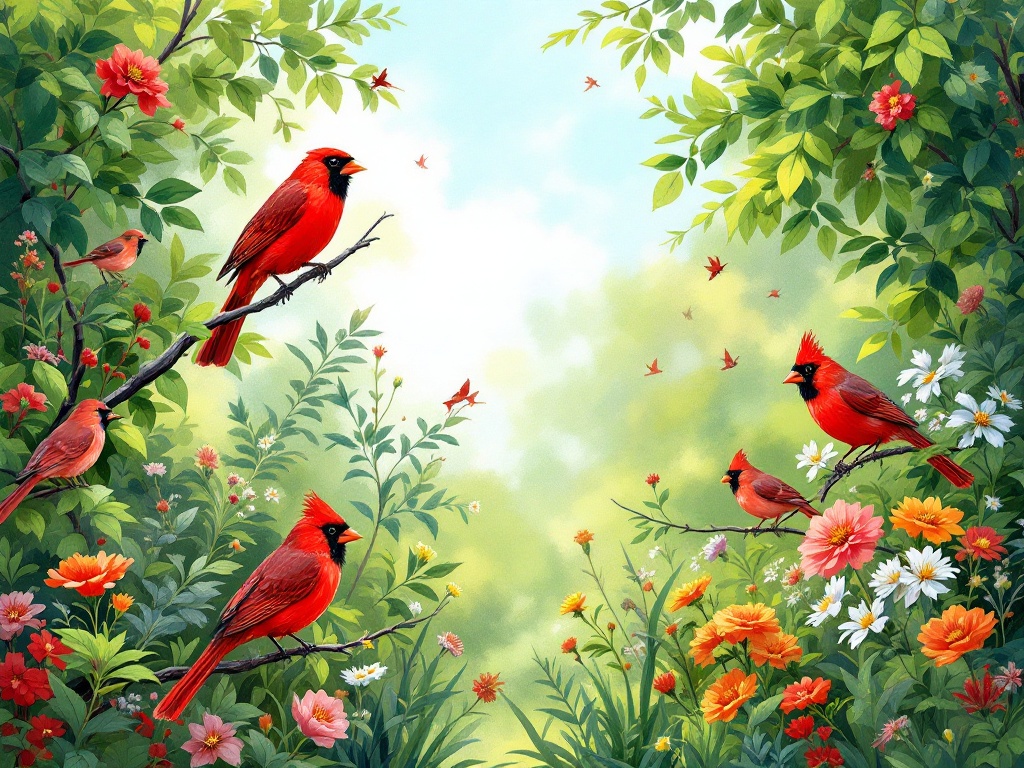List of Red Birds: Have You Already Spotted Them in the Wild
From the fiery Scarlet Tanager to the iconic Northern Cardinal, the world of red birds is a vibrant tapestry of color and song. Discover the fascinating lives of these feathered jewels, from their diverse habitats and unique feeding habits to their captivating territorial displays. Learn how to identify these stunning species and transform your backyard into an avian paradise, attracting these colorful visitors with simple tips and tricks. Dive into the world of red birds and experience the joy of birdwatching like never before.
Important information

- Red birds exhibit a range of red hues, from the vibrant scarlet of the Scarlet Tanager to the deeper crimson of the Northern Cardinal. Some, like the Red Crossbill, have patches of red on a more subdued background.
- These birds occupy diverse habitats. Northern Cardinals prefer gardens and woodlands, while Scarlet Tanagers favor eastern forests. Vermilion Flycatchers are found in the southwest near water, and Red Crossbills inhabit coniferous forests.
- Their diets vary. Northern Cardinals enjoy seeds and fruits, Scarlet Tanagers consume insects and fruits, Vermilion Flycatchers are insectivores, and Red Crossbills specialize in conifer seeds.
- Many red birds are territorial, especially during breeding season. They use songs and calls, or drumming like the Red-headed Woodpecker, to defend their territory and attract mates.
- Attracting red birds to your backyard involves providing food like sunflower seeds, water sources like birdbaths, and shelter such as native shrubs and trees.
Characteristics of Red Birds
Red bird species boast a captivating variety of colors and plumage patterns. The male Northern Cardinal is a vibrant crimson. The Scarlet Tanager is predominantly scarlet with contrasting black wings. The Summer Tanager is a solid, fiery red. The Hepatic Tanager displays a reddish-orange hue, similar to the Vermilion Flycatcher. The Red-Headed Woodpecker is instantly recognizable by its namesake bright red head. Red Crossbills have patches of red against a more subdued grayish-brown. Female red birds often exhibit less vibrant colors; for example, the female Northern Cardinal is mainly brownish with touches of red.
Plumage and Color Variations
Red birds encompass a variety of shades, from the vibrant to the subdued. The Scarlet Tanager and Summer Tanager exemplify the brighter end of the spectrum, boasting fiery scarlet and deep crimson plumage, respectively. The Hepatic Tanager and Vermilion Flycatcher also showcase striking red-orange hues. In contrast, some red birds display more muted tones. The Red Crossbill features dull gray-brown feathers accented with patches of red. The Northern Cardinal’s coat presents a rich, classic red, while the Red-Headed Woodpecker is distinguished by its characteristic crimson head.
Dietary Habits
The Vermilion Flycatcher is an aerial insectivore.
The Northern Cardinal feasts on seeds and fruits.
Similar to the Cardinal, the Scarlet Tanager consumes insects and fruits.
The Red Crossbill has a specialized diet of conifer seeds.
The American Robin prefers earthworms and berries.
Behavior and Territoriality
Northern Cardinals are year-round residents, staunchly defending their territories, especially during breeding season.
Summer Tanagers also exhibit territorial behavior, primarily during breeding season.
Scarlet Tanagers, with robin-like songs, attract mates and warn off rivals.
Vermilion Flycatchers are fiercely protective of their feeding grounds. Unlike the flycatchers, Red-headed Woodpeckers announce their presence and claim territory through drumming, which also serves to attract potential mates.
Breeding Season and Nesting
Red birds exhibit diverse breeding habits, often coinciding with spring and summer. Here’s a closer look at their nesting preferences:
- Northern Cardinals: These birds nest in dense shrubs.
- Scarlet Tanagers: They prefer the upper branches of trees, constructing nests with twigs and grasses.
- Summer Tanagers: Similar to Scarlet Tanagers, they choose high treetop locations.
- Hepatic Tanagers: These birds nest in dense foliage.
- Vermilion Flycatchers: Breaking the mold, they opt for open areas for nesting.
- Red Crossbills: Uniquely, they time their nesting based on conifer seed availability, breeding whenever food is abundant.
Habitats of Red Birds
North America’s diverse habitats are home to a variety of stunning red bird species. The adaptable Northern Cardinal thrives in gardens, shrubs, and woodlands. The vibrant Scarlet Tanager prefers eastern deciduous forests. Its cousin, the Summer Tanager, inhabits open woodlands and scrublands.
- Northern Cardinal: gardens, shrubs, woodlands.
- Scarlet Tanager: eastern deciduous forests.
- Summer Tanager: open woodlands and scrublands.
In the southwest, the Vermilion Flycatcher favors open areas near water. The Red-Headed Woodpecker calls deciduous forests home. Coniferous forests across the continent provide habitat for the Red Crossbill.
- Vermilion Flycatcher: southwest, open areas near water.
- Red-Headed Woodpecker: deciduous forests.
- Red Crossbill: coniferous forests.
Forests offer crucial resources like cover, nesting sites, and plentiful insects and seeds. These resources support species such as the Scarlet Tanager and Red-Headed Woodpecker in eastern deciduous forests, and the Red Crossbill in coniferous forests.
The Scarlet Tanager finds ideal habitat in the eastern U.S., particularly along stream corridors and in deciduous forests teeming with insects and nesting sites.
The open areas near water in the southwestern U.S. offer the perfect habitat and abundant insect prey for the Vermilion Flycatcher.
Backyard birding enthusiasts can attract colorful visitors like the Northern Cardinal with shrubs and feeders. Providing food and water can also entice other red bird species, transforming your backyard into a vibrant avian haven.
Forested Regions
The vibrant Scarlet Tanager thrives in the mature deciduous forests of eastern North America. It relies on the plentiful insects, fruits, and nesting sites found within.
The Summer Tanager prefers the open woodlands and forest edges of the southeastern United States.
Distinct again, the Red-headed Woodpecker carves its niche in the large trees scattered across the central and eastern U.S. forests. Each of these striking red birds depends on these varied wooded landscapes for survival.
Eastern US and Stream Corridors
Vibrant red birds, such as the Northern Cardinal and Scarlet Tanager, thrive near streams in the Eastern United States. These riparian habitats offer plentiful water and food sources. Northern Cardinals, though adaptable to urban environments, reside year-round near these streams, which provide essential insects, berries, and seeds.
Southwestern US and Open Areas
The striking Vermilion Flycatcher flashes brilliant red plumage. It thrives in the open spaces and riparian habitats of the American Southwest, where insects, its primary food source, are abundant. However, this region’s resources and landscapes are also shared with other red bird species.
Backyard Birding Opportunities
Attract vibrant birds like Northern Cardinals, American Robins, and House Finches to your backyard. Provide a diverse menu of sunflower and safflower seeds, suet, fruits, and berries. A fresh water source, such as a birdbath, is essential for drinking and bathing. Native shrubs and trees offer natural food and shelter, creating an ideal bird sanctuary.
Iconic Red Birds of North America
The Northern Cardinal is a striking bird with vibrant red plumage, a black face mask, and a prominent crest.
Unique to North America, the Summer Tanager is the only completely red tanager, showcasing vibrant, solid red feathers.
Adding another splash of color, the Vermilion Flycatcher’s crown, throat, and breast are a bright, eye-catching red.
Equally brilliant, the Scarlet Tanager boasts a scarlet body with contrasting black wings and tail.
In contrast, the Hepatic Tanager displays a deep red-orange hue.
The Red-Headed Woodpecker is instantly recognizable by its entirely red head.
The Red Crossbill, with its uniquely crossed bill perfect for extracting seeds from pine cones, also sports a red body.
Northern Cardinal
The Northern Cardinal is a mid-sized songbird with a striking appearance. Male Northern Cardinals are known for their vibrant red plumage, while females have softer brownish hues with red accents on their wings, tail, and crest. Both sexes share a prominent crest and a sturdy, cone-shaped, orange-red bill. These non-migratory birds are found in the eastern United States year-round. Their clear whistles can be heard in gardens, shrublands, and forest edges. These distinctive songs are essential for communication and mating rituals.
Scarlet Tanager
The Scarlet Tanager is a medium-sized songbird renowned for its vibrant plumage. Males exhibit brilliant scarlet feathers contrasted by jet-black wings and tail. Females, on the other hand, display olive-green feathers with darker wings and tail. These birds primarily inhabit deciduous forests across eastern North America, migrating to South America for the winter. Their diet mainly consists of insects, supplemented by berries and fruit. The tanager’s song, a hoarse, robin-like melody, echoes distinctively through the forest canopy.
Summer Tanager
The Summer Tanager (Piranga rubra), a striking bird found in North America, stands out as the continent’s only completely red species. Adult males boast a vibrant, solid red plumage. Females display a softer yellowish-orange hue. These birds thrive in open woodlands, particularly among oak and pine trees. Their diet consists primarily of bees and wasps, supplemented by other insects and berries. During the warmer months, Summer Tanagers breed and fiercely protect their nests, filling the air with their melodic songs.
Hepatic Tanager
The striking Hepatic Tanager, with its vibrant red-orange plumage, inhabits western North America. This bird enjoys a varied diet of insects and fruits, preferring shrubby habitats where it nests within dense foliage. Its distinct song, particularly noticeable during breeding season, is a key identifier of the species.
Vermilion Flycatcher
The male Vermilion Flycatcher, with its vibrant red-orange plumage, is a striking sight. It’s often seen against the backdrop of its preferred habitat: open areas near water, particularly in the southwestern US. This small but fiery bird sustains itself entirely on flying insects, which it deftly snatches mid-air. Known for their territorial nature, Vermilion Flycatchers aggressively defend their airspace, creating a captivating aerial display.
Red-Headed Woodpecker
The medium-sized Red-headed Woodpecker is instantly recognizable by its vibrant crimson head, a stark contrast to its black back and white underparts and wing patches. This distinctive tri-color pattern sets it apart from other woodpeckers. These birds primarily dine on insects, supplementing their diet with nuts, seeds, and fruit. They also catch insects mid-flight and favor open woodlands with dead trees and high perches. Their loud, ringing calls and drumming serve as communication and territorial defense.
Red Crossbill
Red Crossbills are notable for their crossed beaks, an adaptation that allows them to efficiently extract seeds from pine cones. Their plumage is a blend of gray and brown, accented with red. These birds inhabit coniferous forests across North America, primarily feeding on conifer seeds.
Birdwatching and Identification Tips
Spotting a small red bird? Identifying it depends on size, shape, and color. The male Northern Cardinal, a vibrant red with a prominent crest and black face mask, is unmistakable. Smaller but equally striking, the Scarlet Tanager has brilliant red plumage with contrasting black wings and tail. The House Finch, common in urban areas, shows varying shades of red on its head and chest. For accurate identification, use a field guide.
Attract these birds to your yard
- Offer black oil sunflower seeds, safflower seeds, and Nyjer seeds in tube or platform feeders.
- Plant native berry bushes and trees.
- Provide a fresh water source like a birdbath.
Provide shelter
- Create brush piles.
- Plant dense shrubs for nesting sites.
Identifying Small Red Bird Species
Identifying small red birds requires keen observation and attention to detail. Focus on their size, coloration, and behavior. For instance, the House Finch is often smaller than its red counterparts, with males displaying vibrant red plumage on their head, breast, and rump. Females, conversely, are a streaky brown. The Red Crossbill is easily recognized by its crossed bill, perfect for extracting seeds from cones. Males are a striking brick red, while females are a subtle yellowish hue. Birders can find valuable assistance in field guides and birding apps, which offer detailed comparisons of similar species. Learning bird songs is also an excellent identification tool, as each species possesses a unique vocalization.
House Finch
- Size: smaller than other red birds.
- Male coloration: vibrant red on head, breast, and rump.
- Female coloration: streaky brown.
Red Crossbill
- Distinguishing feature: crossed bill for extracting seeds from cones.
- Male coloration: striking brick red.
- Female coloration: subtle yellowish hue.
Valuable resources for bird identification include field guides and birding apps, which offer detailed comparisons of similar species. Learning bird songs is an excellent way to identify species, as each has a unique vocalization.
Attracting Red Birds to Your Backyard
Attract beautiful birds to your yard by providing food, water, and shelter. Northern Cardinals love sunflower seeds, so fill your feeders with this favorite treat. Planting native shrubs and trees offers both food and a safe place for birds to nest and hide. A bird bath provides fresh water, essential for their survival. Create this welcoming habitat and enjoy the company of these feathered friends.


















